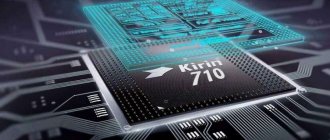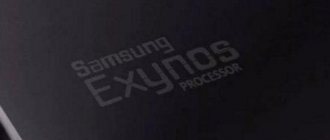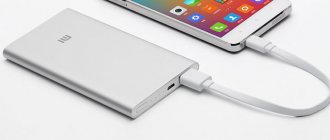Previously , Huawei announced a new series called Kirin 990 , the successor to last year's Kirin 980 . It is available in two versions: 5G and 4G , respectively. These are high-end chipsets that directly compete with the Qualcomm Snapdragon 855 and 855 Plus.
Snapdragon 855 Plus is the same 855 processor , only an improved version. In the article we will conduct a detailed comparison of the characteristics between the Kirin 990 5G, 980 and Snapdragon 855/Plus.
Read also: New powerful Snapdragon 855 Plus processor. Gamers will be delighted
Data transfer rate
Among the world's mobile device manufacturers, HUAWEI occupies a leading position. The production priority is wireless network equipment, network devices, applications and terminals, a wide range of modems that work with all types of networks, including 5G. Kirin 990 has a built-in 5G module, which allows you to increase Internet speeds to 2.3 Gbps. Thanks to the latest technology, a smartphone with such a processor can accelerate to previously unimaginable speeds. For example, movies of the highest quality can be watched without additional loads, which is not always possible with wired Internet. This will allow telecom operators to build more cost-effective networks with large bandwidth. Another feature of the modem is the service of SA/NSA frequencies. This means that the device will always have a stable connection to the network. The location, operating time, type of connection and types of operators will not interfere. Until the widespread arrival of 5G, the production of LTE modems cannot be reduced. This means that remote regions receive high-quality and stable connections.
Snapdragon and Mediatek
It is not very correct to compare branded processors with chipsets from third-party manufacturers, because you can only find the former in smartphones of the company that developed them, and the latter in any device. In particular, processors from Mediatek and Snapdragon are available for different categories of devices. Both manufacturers create chips for both state employees and flagships and mid-range smartphones.
But it’s worth saying that it’s quite difficult to find a flagship with a Mediatek processor. The vast majority of manufacturers prefer Snapdragon, because these chipsets provide smartphones with the most advanced features and high performance. It can’t be said that Mediatek is far behind, but Snapdragon is confidently pushing out its competitor in the market.
However, if you want to save money and buy a cheaper device, a gadget with a Mediatek processor will probably cost less. At the same time, the difference between two similar processors from two manufacturers is not so noticeable.
High energy efficiency
The increase in power of the latest generation phones helps to reduce the battery life of the device. Battery capacity significantly affects the weight of the phone. Increasing energy efficiency helps manufacturers solve this problem. To work with this parameter, developers use a method of reducing the size of the surfaces of parts. The thin chip reduces current leakage, resulting in reduced energy consumption. It becomes possible to fit more chips on a silicon wafer. This leads to a reduction in costs and, accordingly, the cost of the processor. HUAWEI introduced such a chipset last year – Kirin 980, 7 nanometers in size. This served as an impetus for the development of the entire industry.
Camera and Display
Before making any comparison, it's worth noting that the Kirin 990's and full specs display are yet to be updated. So we can just try to predict what they should be.
The manufacturer must provide support for cameras up to 48 megapixels. The company confirms the use of the latest version of Image Signal Processor 5.0 on the Kirin 990 5G. Its camera is capable of recording video up to 4320p 8K at 30 fps and 2160p 4K UHD at 60 fps. The dual ISP Kirin 980 can only record 4K 30fps.
Availability
Price and performance don't always mean the same thing. The final price tag includes many factors. This includes design work, purchasing components for the device, production time, testing, and programming. The pricing policy is aimed at maintaining demand for powerful flagships. Focusing on the middle-class consumer, the cost of a smartphone based on the Kirin 980 chipset remains around 25 thousand rubles, this will allow you to forget about performance problems for several years.
GPU Performance
The new 990 chip has a 16-core Mali-G76MP16 implementation with a frequency of up to 700 MHz. Compared to the Mali-G76MP10 that is used in the 980 series, it has 6 more cores to improve GPU performance. Its competitor uses Adreno 640 with a frequency of 700 MHz. Although all three have very powerful graphics cards, optimization plays a big role.
Kirin 980 is in last position, being an outdated chip. But Snapdragon 855+ and Kirin 990 are very close competitors. Kirin 990 has 15% better throughput and 12% less power consumption. Performance is 6% faster than Qualcomm 855 Plus chip. All three offer essential API support, including OpenGL ES 3.2, Vulkan 1.1, OpenCL 2.0 and DirectX 12.
Mobile processors HiSilicon Kirin characteristics of models.
HiSilicon is the largest Chinese integrated circuit designer, owned by Huawei.
A licensee of ARM microprocessor architecture, it produces Kirin mobile processors based on ARM Cortex and ARM Mali designs for the Huawei and Honor brands. Compared to the products of competitors Samsung Exynos and MediaTek Helio, the characteristics of HiSilicon Kirin mobile processors do not differ significantly (products of the same technology). Qualcomm Snapdragon processors stand somewhat apart, as they use an Adreno video card of their own design. Otherwise, if you weigh the performance of mobile processors HiSilicon Kirin 970 with Mali-G72 MP12 - Samsung Exynos 8895 with Mali-G71 MP20 and Snapdragon 835 with Adreno 540, the conclusion suggests itself - they are links in the same chain. Each subsequent model of a mobile processor is just a response to the release of something, not always new, in the camp of competitors.
Qualcomm was the first to release the Snapdragon 845 with Cortex-A75 cores, taking the lead. In turn, HiSilicon decided to use the latest ARM development with Cortex-A76 cores - Mali-G76, the characteristics of the Kirin 980 processor promise a new level of performance. If there is no breakthrough from third companies or deepening into their developments, we will continue to see this kind of competition between Kirin vs Snapdragon vs Exynos processors for a long time.
My advice to you - before creating queries - Snapdragon or Kirin, Kirin 710 or Snap 710 processor, Kirin 659 vs Snapdragon (any) - take and study the model ranges of competitors' mobile processors, what cores are used (old - new, fast Cortex- A7x or energy-efficient Cortex-A5x), how many computing units the graphics accelerators have (MP), by what standards they are produced (nm).
This will save you from many, sometimes stupid, questions. You can find a comparison of HiSilicon Kirin processors in the table below; to compare with competitors, use the specifications tables - Qualcomm Snapdragon, Samsung Exynos, MediaTek Helio. Characteristics of HiSilicon Kirin mobile processors:
| Model | nm | Number of cores / frequency | Memory/frequency | Video accelerator | Camera support | Video capture |
| Kirin 980 | 7 | 2x Cortex-A76 up to 2.6 GHz 2x Cortex-A76 up to 1.92 GHz 4x Cortex-A55 up to 1.8 GHz | up to 8GB LPDDR4x 2133MHz | Mali-G76 MP10 720 MHz | 1x up to 40MP 2x up to 16MP | 4K 30 fps 1080p 120 fps |
| Kirin 970 | 10 | 4x Cortex-A73 up to 2.36 GHz 4x Cortex-A53 up to 1.84 GHz | up to 8GB LPDDR4x 1866MHz | Mali-G72 MP12 572 MHz | 1x up to 28MP 2x up to 16MP | 4K 30 fps 1080p 120 fps |
| Kirin 960 | 16 | 4x Cortex-A73 up to 2.36 GHz 4x Cortex-A53 up to 1.84 GHz | up to 8GB LPDDR4 1794MHz | Mali-G71 MP8 546 MHz | 1x up to 28MP 2x up to 16MP | 4K 30 fps 1080p 120 fps |
| Kirin 955 | 16 | 4x Cortex-A72 up to 2.5 GHz 4x Cortex-A53 up to 1.84 GHz | LPDDR4 1333MHz | Mali-T880 MP4 900 MHz | 1x up to 24MP 2x up to 13MP | 4K 30 fps 1080p 60 fps |
| Kirin 950 | 16 | 4x Cortex-A72 up to 2.36 GHz 4x Cortex-A53 up to 1.84 GHz | LPDDR4 1333MHz | Mali-T880 MP4 900 MHz | 1x up to 24MP 2x up to 13MP | 4K 30 fps 1080p 60 fps |
| Kirin 935 | 28 | 4x Cortex-A53 up to 2.2 GHz 4x Cortex-A53 up to 1.5 GHz | LPDDR3 1600MHz | Mali-T628 MP4 680 MHz | 1x up to 16MP | 1080p 30 fps |
| Kirin 930 | 28 | 4x Cortex-A53 up to 1.9 GHz 4x Cortex-A53 up to 1.5 GHz | LPDDR3 1600MHz | Mali-T628 MP4 600 MHz | 1x up to 16MP | 1080p 30 fps |
| Kirin 928 | 28 | 4x Cortex-A15 up to 2.0 GHz 4x Cortex-A7 up to 1.3 GHz | LPDDR3 1600MHz | Mali-T628 MP4 600 MHz | 1x up to 16MP | 1080p 30 fps |
| Kirin 925 | 28 | 4x Cortex-A15 up to 1.8 GHz 4x Cortex-A7 up to 1.3 GHz | LPDDR3 1600MHz | Mali-T628 MP4 600 MHz | 1x up to 16MP | 1080p 30 fps |
| Kirin 920 | 28 | 4x Cortex-A15 up to 1.7 GHz 4x Cortex-A7 up to 1.3 GHz | LPDDR3 1600MHz | Mali-T628 MP4 600 MHz | 1x up to 16MP | 1080p 30 fps |
| Kirin 910T | 28 | 4x Cortex-A9 up to 1.8 GHz | LPDDR3 1333MHz | Mali-450 MP4 700 MHz | 1x up to 16MP | 1080p 30 fps |
| Kirin 910 | 28 | 4x Cortex-A9 up to 1.6 GHz | LPDDR3 933MHz | Mali-450 MP4 533 MHz | 1x up to 16MP | 1080p 30 fps |
| Model | nm | Number of cores / frequency | Memory/frequency | Video accelerator | Camera support | Video capture |
| Kirin 710 | 12 | 4x Cortex-A73 up to 2.2 GHz 4x Cortex-A53 up to 1.7 GHz | LPDDR4 1794MHz | Mali-G51 MP4 650 MHz | 1x up to 24MP 2x up to 16MP | 4K 30 fps 1080p 120 fps |
| Kirin 659 | 16 | 4x Cortex-A53 up to 2.36 GHz 4x Cortex-A53 up to 1.7 GHz | up to 8GB LPDDR4x 1794MHz | Mali-T830 MP2 900 MHz | 1x up to 22MP | 4K 30 fps 1080p 60 fps |
| Kirin 658 | 16 | 4x Cortex-A53 up to 2.35 GHz 4x Cortex-A53 up to 1.7 GHz | LPDDR3 933MHz | Mali-T830 MP2 900 MHz | 1x up to 22MP | 4K 30 fps 1080p 60 fps |
| Kirin 655 | 16 | 4x Cortex-A53 up to 2.12 GHz 4x Cortex-A53 up to 1.7 GHz | LPDDR3 933MHz | Mali-T830 MP2 900 MHz | 1x up to 22MP | 4K 30 fps 1080p 60 fps |
| Kirin 650 | 16 | 4x Cortex-A53 up to 2.0 GHz 4x Cortex-A53 up to 1.7 GHz | LPDDR3 933MHz | Mali-T830 MP2 900 MHz | 1x up to 22MP | 4K 30 fps 1080p 60 fps |
| Kirin 620 | 28 | 4x Cortex-A53 up to 1.2 GHz 4x Cortex-A53 up to 1.2 GHz | LPDDR3 900MHz | Mali-450 MP4 533 MHz | 1x up to 16MP | 1080p 30 fps |
| K3V2E | 40 | 4x Cortex-A9 up to 1.5 GHz | LPDDR2 400 MHz | Vivante GC4000 240 MHz | 1x up to 5MP | 720p 24 fps |
| K3V2 | 40 | 4x Cortex-A9 up to 1.4 GHz | LPDDR2 400 MHz | Vivante GC4000 240 MHz | 1x up to 5MP | 720p 24 fps |
| Model | nm | Number of cores / frequency | Memory/frequency | Video acceleration / frequency | Camera support | Video capture |
For those who are in the chaotic stage of choosing a new smartphone, I recommend reading which smartphone is better to choose. Advice - without advertising noodles - will benefit you.
Autonomy of devices based on Kirin 659 and Snapdragon 625 chipsets
Autonomy analyzes are not representative. When comparing chipsets, Snapdragon's advantage is significant.
At the same time, previous comparisons of the Kirin 65x sometimes showed it to be ahead of the Snapdragon 625, which often serves as an ideal in terms of energy efficiency. We suggest that you familiarize yourself with the table comparing autonomy by intended purpose - evaluate the phones, but do not make final conclusions based on processors.
| Kirin 659 vs. Snapdragon 625: battery consumption | ||||
| Huawei Mate 10 Lite | Honor 7X | Moto Z Play | Xiaomi Mi A1 | |
| Screen | 5.9, FHD+ | 5.9, FHD+ | 5.5, FHD | 5.5, FHD |
| Battery | 3340 mAh | 3340 mAh | 3510 mAh | 3080 mAh |
| Autonomy rating | 76 hours | 77 hours | 100 hours | 87 hours |
| 3G calls | 19:49 | 20:41 | 30:26 | 20:11 |
| Internet | 08:50 | 10:10 | 15:39 | 13:20 |
| Video | 10:17 | 09:23 | 18:26 | 11:00 |
Antutu-GeekBench results
The Geekbench Snapdragon 855+ scores 3,623 single-core and 11,365 multi-core. The Kirin 980 scores 3325 points for single-core and 9784 points for multi-core.
Moving on to Antutu , the SD 855 Plus can score 4,97,179 points while the Kirin 980 scores 3,13,567 points in Antutu . Kirin 990 5G is a relatively new chipset, so we can’t get test results yet.
Conclusion - which one is better?
Thanks to the comparisons, you can see that only the Kirin 990 and Snpadrsgon 855+ compete with each other. The Kirin 980 is still a powerful processor, but it can't compare to the other two. The two processors are equipped with the latest technologies. Kirin 990 has high performance. Snapdragon 855+ has better camera specifications.
But, the Snapdragon is used in many smartphones of different price segments. Kirin 990 is limited to Huawei flagships.
Read also: XIAOMI MI 9 VS REDMI K20 PRO: review and comparison of two smartphones
Smartphones with Snapdragon 855 processor
- Xiaomi Mi 9
- Black Shark 2
- Xiaomi Mi 9T Pro
- Redmi K20 Pro
Mali-T830 MP2 vs Adreno 506
HiSilicon processors use Mali accelerators. Kirin 659 is equipped with Mali-T830 MP2, an adapter with two cores operating at 900 MHz. Qualcomm uses its own development – Adreno graphics. The Snapdragon 625 has Adreno 506 installed, the adapter pulse frequency is limited to 650 MHz.
Adreno graphics are more interesting than Mali: more efficient, faster, more tailored to famous games. To more accurately estimate the power of the adapter, gigaflops are used, indicating how many floating point operations the chipset can perform in 1 second.
The table shows the number of floating point operations performed by different generations of Mali GPU and Adreno GPU.
The Mali-T830 MP2 graphics performs significantly fewer processes per second than the Adreno 506.











